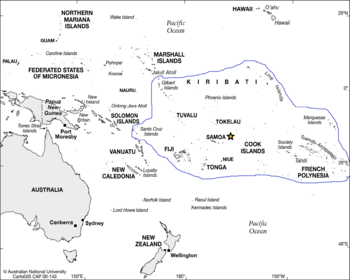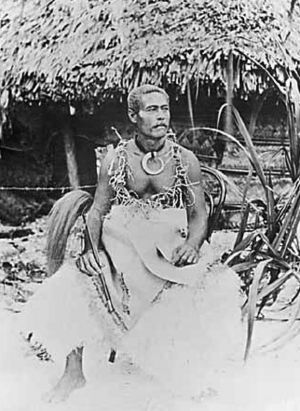Tui Manu'a facts for kids
Quick facts for kids
Tui Manuʻa Confederacy
|
|
|---|---|
 |
|
| Capital | Fitiuta |
| Official languages | Samoan |
| Recognised regional languages | Tongan Fijian Futunan Niuean Uvean Tuvaluan Tokelauan Maori i-Kiribati Tahitian Rotuman Pukapukan |
| Religion | Samoan Mythology |
| Government | Monarchy |
| Tu'i Manu'a | |
| Historical era | Pre-Tongan |
| Today part of | Samoa Tonga Fiji American Samoa Niue Wallis and Futuna Tuvalu Tokelau Cook Islands Kiribati Rotuma French Polynesia |

The Tui Manuʻa was the name for the main leader or chief of the Manu'a islands. These islands are now part of American Samoa.
Sometimes, people call the time when the Tui Manuʻa leaders were powerful the Tuʻi Manuʻa Confederacy or the Samoan Empire. This was a period when the Samoan people expanded their influence across Oceania. Old stories from Samoa and Manuʻa tell us about a large network or group of Polynesian islands that were connected.
Contents
History of the Tui Manuʻa Leaders
The Tui Manuʻa title is one of the oldest in Samoa. According to Samoan and Tongan stories, the first Tui Manuʻa was a direct descendant of the Samoan supreme god, Tagaloa.
In Samoan legends, the islands of Manu'a (Ofu, Olosega, and Ta'u) were the first lands created. Because of this, the Tui Manuʻa is seen as the very first human ruler. Even though no one has held the title since the early 1900s, Samoans still respect its high rank.
The Tui Manuʻa Confederacy: An Ancient Network
Old stories from Samoa and Tonga talk about a large network of Polynesian islands. These islands were once ruled by the Tui Manuʻa leaders. Manuʻan family histories and religious stories suggest that the Tui Manuʻa had been a very important and powerful chief in the Pacific for a long time. They were seen as the first main ruler of all Samoa.
Oral history suggests that the Tui Manuʻa kings led a group of islands far and wide. This group included Fiji, Tonga, and smaller islands like Uvea, Futuna, Tokelau, and Tuvalu. People traded goods between these western Polynesian societies. It is thought that the Tui Manuʻa leaders became powerful by controlling this ocean trade. They traded valuable items like finely woven mats, whale ivory "tabua" (special teeth), obsidian and basalt tools, red feathers, and rare seashells.
Decline and Isolation of the Tui Manuʻa
Over time, the Tui Manuʻa's influence began to lessen. A new powerful group, the Tu'i Tonga, started to grow from the South. Around 950 AD, the first Tu'i Tonga leader, 'Aho'eitu, began to expand his rule.
Samoa's Savaii, Upolu, and Tutuila islands eventually came under Tongan rule. They remained part of the Tongan empire for almost 400 years. However, the Manuʻa islands were special to the early Tongan kings. They were considered sacred because they were the homeland of the Tu'i Tonga family and gods like Tagaloa. Because of this, the Tongans never took over Manuʻa. This allowed the Tui Manuʻa leaders to continue their rule there.
By the 13th century, the Tongans were pushed out of Upolu and Savaii. But these islands did not return to Tui Manuʻa rule. Instead, a new powerful group, the Malietoa, rose to power. They freed Samoa from the Tongan rulers. This led to a new political system in Upolu and Savaii that lasted for nearly 300 years. Even though the Tui Manuʻa never ruled the surrounding islands again, the title is still highly respected. It is seen as the origin of many important Samoan and Tongan families.
Colonization and the End of the Tui Manuʻa Title
The Manuʻa islands, along with Tutuila and Aunuʻu, became part of the United States. This area is now called American Samoa. The US government and Navy took over the role of the Tui Manuʻa. Chiefs of the Tui Manuʻa were arrested, and there were two trials for the Tui Manuʻa. One trial, called the "Trial of the Ipu," happened on an American warship near Taʻu.
On July 6, 1904, Tui Manu'a Elisala officially gave the Manuʻa islands to the United States. He signed the Treaty of Cession of Manu'a. He was given the job of Governor of Manuʻa for life. It was understood that the Tui Manuʻa title would end with him. He passed away on July 2, 1909.
After 15 years, the title was brought back in 1924. Chris Young, a member of the Tui Manuʻa family, was named Tui Manuʻa. He was the brother of Tui Manuʻa Matelita, who ruled from 1890 to 1895. American officials were worried that the Manuʻans were bringing back a "king" who might cause problems. Governor Edward Stanley Kellogg did not agree with this. He had the new Tui Manuʻa brought to Tutuila. There, Chris Young was stopped from using his powers as Tui Manuʻa. The Governor did not recognize the title. He said that a monarchy did not fit with the Constitution of the United States. He also stated that the previous Tui Manuʻa had promised to be the last person to hold the title.
Many people today are descendants of the Tui Manuʻa.
List of Tui Manuʻa Leaders
Here is a list of the leaders who held the Tui Manuʻa title:
- Satiailemoa
- Tele (brother of Satiailemoa)
- Maui Tagote
- Maugaotele
- Folasa or Taeotagaloa
- Faʻaeanuʻu I or Faʻatutupunuʻu
- Saoʻioʻiomanu (eldest son of Faʻaeanuʻu I)
- Saopuʻu (second son of Faʻaeanuʻu I)
- Saoloa (third son of Faʻaeanuʻu I)
- Tuʻufesoa (fourth son of Faʻaeanuʻu I)
- Letupua (fifth son of Faʻaeanuʻu I)
- Saofolau (sixth son of Faʻaeanuʻu I)
- Saoluaga
- Lelologatele (eldest son of Saofolau)
- Aliʻimatua (eldest son of Lelologatele)
- Aliʻitama (second son of Lelologatele)
- Tui Oligo (grandson or son of Aliʻitama's daughter)
- Faʻaeanuʻu II (eldest son of Tui Oligo)
- Puipuipo (second son of Tui Oligo)
- Siliʻaivao (third son of Tui Oligo)
- Tuimanufili (daughter of Faʻaeanuʻu II)
- Faʻatoʻalia Manu-o-le-faletolu (eldest son of Tuimanufili)
- Segisegi (son of Faʻatoʻalia)
- Siliave (daughter of Faʻatoʻalia)
- Tui-o-Pomelea (son of Siliave)
- Tui-o-Lite (or Tui Aitu) (son of Tui-o-Pomelea)
- Toʻalepai (son of Tui-o-Lite)
- Seuea (daughter of Toʻalepai)
- Salofi (brother of Seuea)
- Levaomana (son of Salofi)
- Taliutafapule (son of Salofi and brother of Levaomana)
- Taʻalolomana Muaatoa
- Tupalo
- Seiuli
- Uʻuolelaoa
- Fagaese
- Tauveve
- Visala
- Alalamua
- Matelita or Makelita (1872–1895), ruled 1891–1895
- Elisala or Elisara (died 1909), ruled 1899–1909
- Chris (Kilisi) Taliutafa Young (1924)
|
||||||||||||||||||||||||||||||||||||||||||||||||||||||||||||||||||||||||||||||||||||||||||||||||||||||||||||||||||||||||||||||||||||||||||||||||||||||||||||||||||||||||||||||||||||||||||||||||||||||||||||||||||||||||||||||||||||||||||||||||||||||||
See also
 In Spanish: Tui Manu'a para niños
In Spanish: Tui Manu'a para niños


